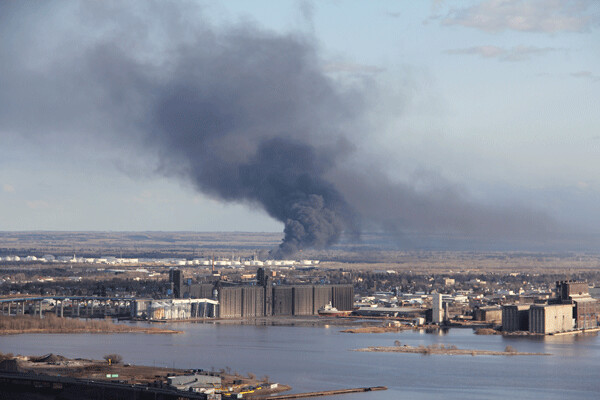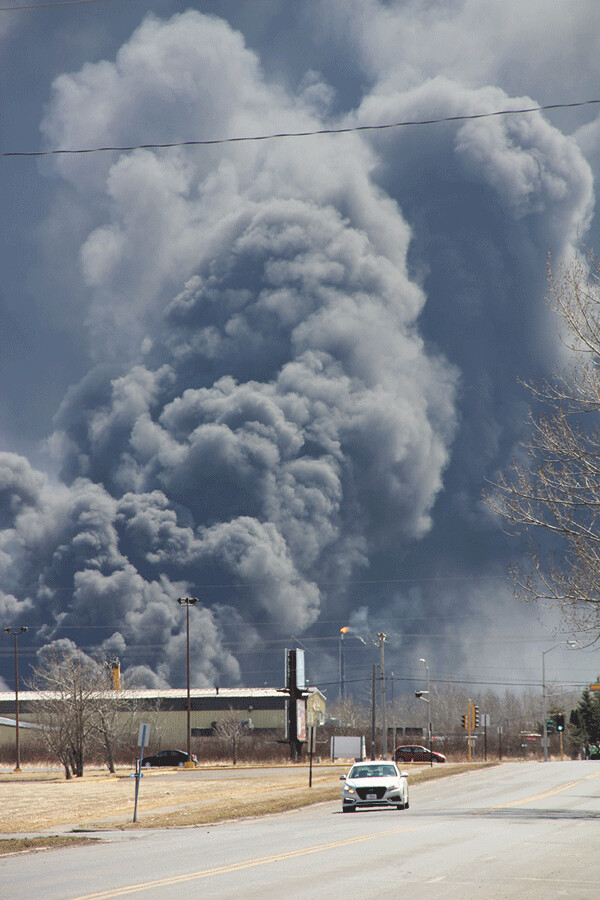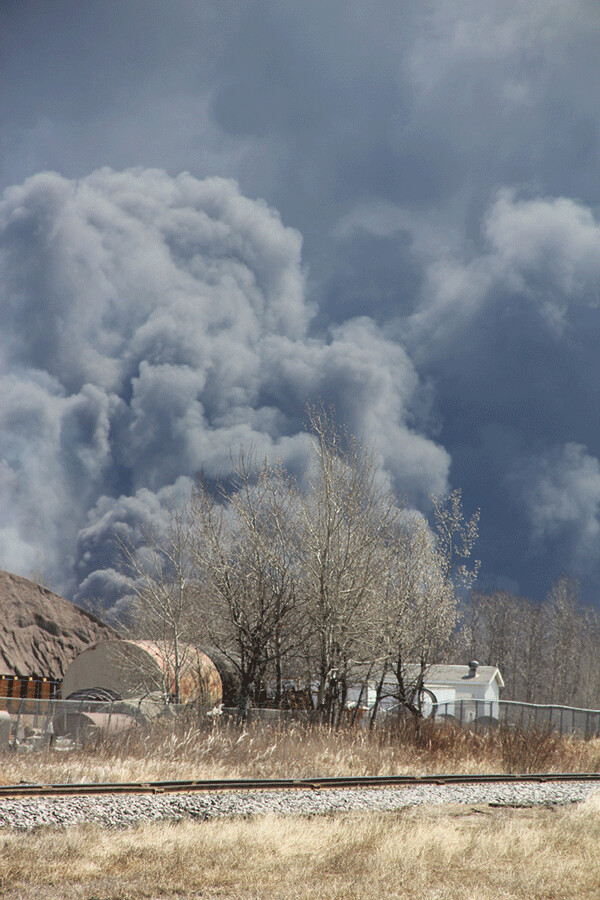News & Articles
Browse all content by date.

The April 26 explosion at the Husky oil refinery in Superior resulted in the uncontrolled release of toxic pollutant s and left many questions about possible long term health effects from this exposure. The fire caused a toxic plume which has deposited toxic residue onto the land. My estimate for the area of contamination starts at the fire location and extends 30 miles south and five miles east and west. If you live in this area you can use the information in this article to decide how you want to use your land this year.
Husky’s business is oil
The Husky oil refinery creates many products from crude oil. Crude is a mixture of many different hydrocarbons. Refineries separate the components of the mixture into various products: from small, simple molecules (LPG, gasoline) to medium molecules (jet fuel, diesel) to the heaviest molecules (fuel oil, wax, and asphalt). The crude mixture often has too little of some components (gasoline) and too much of others (fuel oil, asphalt). Refining separates the mixture components and can chemically alter them to create more of the wanted components and use up the unwanted ones. For example, catalytic cracking is a process to convert fuel oil or asphalt into gasoline. News reports suggested the fire started at the cat-cracker. We will need to wait for the various investigating agencies to complete their work before we know what caused the fire.
Husky’s fire created and released many different toxic compounds
The fire created a large cloud or plume formed from the uncontrolled burning of oil. The plume contained many substances that are immediately dangerous to health and life. This includes carbon monoxide, hydrogen sulfide, sulfur dioxide, volatile organic compounds (VOCs), and particulate matter (PM). If you inhale them they will create cold like symptoms – headache, runny nose and eyes, dizziness, coughing, and light headedness. The symptoms may take a week to go away. A healthy person will usually fully recover with no long term problems from such an incident.
Unfortunately, this fire involved the heavy components of the oil, like the asphalts. When released into the air, they are considered to be a hazardous air pollutant (HAPs) because asphalt includes polycyclic organic matter or polycyclic aromatic hydrocarbons (PAHs) - organic molecules that contain more than one benzene ring and have a boiling point greater than 212 oF. During an uncontrolled fire this material will vaporize (50%), burn (20%), or partially burn (30%). If it burns completely it will form carbon dioxide and water. When it partially burns it forms a huge range of new molecules, including carbon monoxide, benzene, and multiple PAHs. In general the partially burned material is more toxic than the original material. A single, short term exposure to these compounds, such as inhalation of the plume from a fire, is usually not correlated with long term health problems. Multiple exposures over long periods of time to even extremely small amounts is correlated with health problems such as cancer, heart disease, and respiratory problems. The exposure can occur through any combination of inhalation, ingestion, or skin contact.
The compounds traveled downwind in a plume to meet their fate
The plume moved away from the fire, pushed aloft by the high temperatures (which create buoyancy like seen in hot air balloons) and pushed across the land by the wind. As it travels, the materials inside it will spread out. Eventually there are two things that happen to compounds in the plume - destruction by reaction or deposition on the ground. Nothing in the plume just disappears – it all goes somewhere and something will happen to it.
Reaction of the organic compounds completes the burning process to form carbon dioxide and water. The time this takes varies by the structure of the molecule – VOCs may take a few days, carbon monoxide takes about 2 months, and PAHs can take a year. Reaction of the sulfur compounds to form sulfates such as sulfuric acid takes days to weeks.
Deposition of the materials in the plume may occur as a wet or dry process. The sulfur products will eventually exit the plume as acid rain. A large factor in deposition is the fact that all of the substances can glom onto each other and/or with water droplets to form larger particulate matter. When the particulates get large enough they will fall to the ground, thus removing the material from the air. A typical size particulate may take a few minutes to a few hours to fall the 5,000 feet the plume reached. Wind speeds were 10 – 20 miles per hour during the fire, which could carry the largest particulates 1 or 2 miles downwind, and the smaller particulates 20 – 30 miles downwind or even farther. The wind was mostly from the north so the plume traveled south. There were also wind direction variations which caused the plume to move a bit east or west at different times and increasing the spreading out of the plume. These values can be used to determine the extent of the land that was contaminated (30 miles south and five miles east and west starting at the refinery).

Toxics left the air and deposited into the water and onto the land.
Once the fire is out and the plume blows away, it is replaced with clean air. The Wisconsin DNR has already reported that the air has returned to good levels for the substances it measures. Search the internet for EPA and NAAQS to learn what is considered good air quality. However, the plume left its mark on the water and soil. There have been anecdotal reports of oil sheens in the Pokegama wetlands and on the Nemadji river. I have also heard of observations of oily, dark clods and white fibrous material (insulation? Is it asbestos?) lying on the ground one to two miles downwind. These materials should not be touched, instead you should report these observations to Husky [call Husky’s Superior assistance line at 1-800-686-3192 or 1-855-527-5002] and the Wisconsin DNR [https://dnr.wi.gov/contact/ ] to have them removed properly by people in protective gear. If they are asphalt residue or asbestos it is a health risk to come in contact with it. It is ok to take photos and to tell others what you have observed.
Smaller particulates traveled further downwind before they deposited on the land. These particulates can be too small to notice or to see. It may even be difficult to find them using the best available chemistry equipment. It should be noted that a laboratory test that states the material is below detection limit does not mean it is zero, it only means that it is less than the stated detection limit. Current test methods are not sensitive enough, and the procedures for environmental sampling are often inadequate for detecting small amounts of PAH compounds in soils. The compounds from the fire did not just disappear they had to land somewhere. However, given enough time and access to sunlight, microbes (including fungi), and water these materials will decompose. In undisturbed soil this process takes about one year. If you work or till the soil, the materials can be buried deeper and it may take several years for them to decompose.

Health risks is from contact and ingestion
The harm to humans and animals occurs when these substances are taken in to the body. The harm to an individual depends on the length of exposure, the amount of exposure (the dose), and the habits of the person. PAH’s cause more harm to people who are exposed to them regularly (workers and smokers). They are less harmful when it is a short term exposure. The harm is also proportional to the amount of material taken into the body, with all routes (breathing, eating, and skin contact) adding to the overall dose. Certain groups of people will, in general, be more likely to be harmed (children, elderly, those with compromised immune system, smokers, and refinery workers).
It is very difficult to determine an individual’s health risk from PAHs. Most of the data comes from direct laboratory exposures on small mammals. There have been very few studies on people, except as incidental reports typically involving workers exposed during accidents. The fact that there are so many different forms of molecules within this class also makes it difficult to study – do you look at one representative molecule that is easy to measure, or do you look at an entire collection of different molecules but have no way to quantify what is actually present? Regardless, all the data suggests that larger doses and longer term exposures increase the chance of an adverse health effect.
Advice to help you make decisions
The material that lands on the soil will most likely stay there until it is broken down by sunlight and microorganisms (about one year). The part that lands in waterways will be washed downstream and eventually be deposited in lake sediments, where it will also take about a year for them to be destroyed. Note that there will be some small fraction of these substances that will not be destroyed and will linger for much longer times.
My research on bioremediation of heavy metals by plants shows me that plants will absorb anything and everything they contact in the soil, water, or air. Some plants will contain levels similar to their surroundings. Some plants will concentrate the materials above the background level, a process called biomagnification. It is not uncommon for a plant to concentrate a substance (organic or inorganic) to have levels ten times greater than the surrounding environment. I am not aware of any study that concludes plants can completely reject a material in its surroundings.
The threat from inhalation has passed. The threat from skin contact and ingestion is ongoing and can be countered by choosing actions that avoid these exposures – do not eat food grown in soil from the fallout zone (for a year) and avoid contact with the soil and water in the area.
My advice as a father of three and as a chemical engineer for people living in the plume fallout zone is:
• Plant flowers, not food in your garden this year, and wear disposable gardening gloves,
• Do not let children or pets play in the dirt for at least a year (or consider replacing your sandbox with new sand).
• No swimming/ fishing in lakes within the fallout zone for a month, rivers are probably ok, and
• Fruit and nut trees will probably be ok.

FAQs
Should you get your soil tested?
No. The tests are expensive (costing more than a year’s supply of fruit and veggies from the farmers market). They require special sampling protocols (more money to bring a trained lab person out), and the results are usually inconclusive. Undetected means below the sampling threshold, it does not mean zero. There are 100,000s of potential compounds that were deposited by the plume. The most useful tests look for a specific compound – which to choose? While the tests can detect very small amounts in an otherwise clean sample, your soil will have all sorts of complicating factors. I recommend you do not get your soil tested.
Will my well-water get contaminated?
That depends on which part of the underlying aquifer your well pulls water from. A deeper well is less likely to get contaminated. See if you are eligible for testing from Husky or the Wisconsin DNR. It may take time before any contaminant shows up – even several years.
Do I need a lawyer?
I don’t know and am unqualified to provide legal advice. If you are curious, ask a lawyer for their opinion.
Can I mow my lawn?
Yes. The contaminants are on top of the soil. The grass hadn’t emerged at the time of the plume deposition. It is unlikely to have much on it. Use the normal safety procedures for mowing – wear closed toes shoes, long pants, and gloves. You want to prevent contact with the soil.
Can I just water the soil and wash it away?
No, these particulates are oily, they stick to the soil and have low water solubility. However, the water may help keep the soil organisms happy and growing. They will eat the toxins for you.
What about my animals?
It is very difficult to keep animals from contacting the soil. Send them away for the summer to a friend that is not in the plume fallout zone, or keep them indoors. If you have to keep them on contaminated soil – wash them frequently. Understand that their chances of a health risk problem will be increased.
What can I do to make it better?
Wait a year before using your soil or plant flowers or cover crops to invest in making your soil healthy for next year. Try to encourage the decomposer organisms (microbes, fungi, worms, etc…) by watering occasionally if it is a dry time.
Learn more
(hey – I am a professor, I want you to learn more)
Want to learn more about environmental concerns where you live? Your government has tremendous amounts of free information for you to use. These links will help you get started. Hint when using the mapping tools – start small, use your zip code, slowly scale out. The databases are very large and it can take a while to load if you ask for information in too big an area. Second hint, if the tool has a tutorial – use it.
• US EPA Environmental Justice Screening tool https://www.epa.gov/ejscreen or search {EJScreen}
• US EPA Toxics Release Inventory https://www.epa.gov/toxics-release-inventory-tri-program or search {EPA TRI}
• https://www.cdc.gov/biomonitoring/chemical_factsheets.html or search {cdc biomonitoring}
• Agency for Toxic Substances and Disease Registry (ATSDR) https://www.atsdr.cdc.gov/ or search {atsdr}
• The deep background for every economic activity in the US is covered in the US EPAs AP-42 archive. It self identifies as air emission factors, but it provides a general overview of each industry. https://www.epa.gov/air-emissions-factors-and-quantification/ap-42-compilation-air-emissions-factors or search {EPA AP-42 optionally include the economic concern such as refinery}
• Minnesota has an incredible tool called what’s in my neighborhood. It tells you everything the Minnesota Pollution Control Agency has within the state https://www.pca.state.mn.us/data/whats-my-neighborhood or search {MPCA neighborhood}
Dr. Steven Sternberg, PE
Associate Professor Chemical
Engineering
University of Minnesota Duluth.
Note that I am writing as a chemical engineer and citizen. My research areas explore how contaminates move and react in the environment, and how plants can be used to remove contaminants from polluted areas. I do not speak for the University of Minnesota. I have no economic interest in Husky, nor any property in the impacted or surrounding areas. My goal is to provide my knowledge with the hope of preventing any adverse health effects within our community.
| Tweet |

